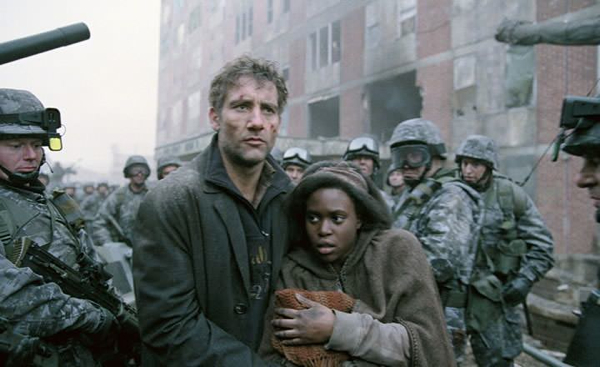Movie review by Greg Carlson
A powerful and thought provoking bazooka of a movie, “Children of Men” represents the best work yet from director Alfonso Cuaron. Based on P.D. James’ dystopian novel, “Children of Men” is stunningly accomplished, from its incorporation of “Blade Runner” style retro-futurism to the woozy, visceral immediacy of its photography. Despite its bleak, nightmarish vision of 2027, the film carries with it an undeniable sense of hope, and the experience of viewing it will leave many with a profound desire for self reflection. There’s no clever Easter Egg following the end credits, merely one word repeated three times that reminds us of the movie’s leitmotif.
Carved with some of the same gritty, documentary-style design as Paul Greengrass’ gripping “Bloody Sunday,” “Children of Men” places the viewer in the center of its alarming universe, a police-state Great Britain, which turns out to have the last functioning government in the world. Following an infertility epidemic, no babies have been born on the planet for 18 years. A terrorist organization known as the Fishes wreaks much havoc in fierce battles with government soldiers assigned to the streets to staunch the waves of refugees, called “fugees,” attempting to breach fences designed to keep them out. With no apparent future, the earth descends into chaos and despair.
The movie’s exposition is largely accomplished in the margins of its stellar production design, courtesy of Geoffrey Kirkland and Jim Clay. We learn of the cult of personality surrounding “Baby Diego,” a worldwide celebrity due to his status as the globe’s youngest person. We also see advertisements for companies peddling suicide kits, as well as other spots for procedures designed to help people preserve their youth. Orwellian public service announcements warn citizens to report suspected illegal immigrants. In the midst of it all, hard-drinking Theo Faron (a terrific Clive Owen) is reluctantly caught up in an odyssey to shepherd some very precious cargo to a group of activists en route to a mysterious rendezvous that may or may not exist.
Matching the quality of the production design is the visual impact provided by Emmanuel Lubezki’s phenomenal work as the film’s director of photography and George Richmond’s almost unprecedented skill as camera operator. Several carefully rigged sequences, including a hair-raising car/motorcycle chase and a long, unbroken shot (digitally stitched together from several takes) during a ferocious urban battle, will provide movie lovers and cinematography fanatics with study material for years to follow. Few films in recent memory come as close to placing the viewer at the pounding heart of the action.
Detractors have sniped that the movie fails to address the wealth of issues raised by its intriguing premise, and several conservative critics have lashed out at the perceived liberties taken by Cuaron in transposing the novel to the screen. Cuaron strikes a balance, however, allowing his audience to puzzle out many of the movie’s enigmas. Other answers are intentionally missing. Where some see only indelicate broadsides leveled at the current state of U.S. policy, in terms of the war in Iraq and other ills of the Bush administration, others will discover a subtler parable that raises questions more than it points fingers.
